I’ve been meaning to write about this topic for a while—now xkcd has beaten me to it:
Oh, well. Since the comic doesn’t actually answer the question, I’m hoping you’re all still interested! (Also, at the end there will be a bonus discussion of ant rain. Yes, ant rain. You won’t find that on xkcd!)
You’ll notice I’ve changed the question a bit from the xkcd comic: where Randall Munroe asks “Where do birds go?” I’d like to answer “What do birds do?”—because birds don’t necessarily go anywhere when it rains.
Rain poses two major possible dangers to a bird. The biggest one is hypothermia: birds stay warm by trapping tiny pockets of air under their feathers, and if those pockets fill with water instead of air, that bird is going to get cold very quickly. (This is why down jackets don’t work when wet.) American Kestrels exposed to rain increase their metabolic rate, presumably to compensate for heat loss (Wilson et al. 2004).
The smaller the bird, the bigger a problem this is, since smaller birds have higher surface-area-to-volume ratios, meaning they lose heat more quickly, and they generally have smaller energy reserves.
Already you can see how avian responses to rain might depend on the bird: small birds might seek out shelter more readily than large birds, to avoid getting wet and cold. Indeed, while smaller birds sought shelter during one torrential rain, a flock of Turkey Vultures was seen perched at the tops of tree with wings spread, rain-bathing (Hume 1986).
Birds can and do take shelter from rain: in bushes, in reeds, under eaves, in nesting cavities. But this is necessarily a short-term solution, because birds also need to eat. This is the second possible danger of rain: starvation. You can hide from an afternoon shower, but a week-long downpour is not something you can wait out, especially if you’re a small bird without much stored energy. You’re going to have to eat, and to do that, you’ll have to get wet.
(If you haven’t already, check out the videos of hummingbirds flying in heavy rain at the end of this older post.)
I’ve seen this in the field: birds may briefly disappear when rain first starts, but if it lasts any length of time, the birds start to reappear. They can’t afford to stop foraging—especially if they have chicks to feed.
Length isn’t the only aspect of rain that matters—intensity makes a difference too. A sufficiently light rain probably won’t be a problem. Most bird feathers are somewhat water resistant, and in light rain, you may see birds fluffed up, just as they would in a dry cold.
Heavy rain calls for a different tactic. Fluffing up your feathers keeps you warm, but if the rain is heavy enough, water will get in between your fluffed-up feathers and chill you faster. Instead, in heavy rains birds sleek down their feathers to reduce their wettability.
The classic bird-in-heavy-rain posture, as described by Hume (1986), is “head withdrawn, bill pointed towards the rain, body rather upright and feathers sleeked,” a pose which combines staying warm (“head withdrawn” is a heat-conserving position), minimum exposure of the bird to rain, and maximum opportunity for raindrops to slide off the feathers rather than being absorbed. Birds may take up this posture when they don’t have access to shelter. Shorebirds in the rain have been observed huddled close together, all in this posture (Hume 1986).
So where do birds go in the rain? To shelter, or not. Out to lunch, or not. In to huddle with some buddies, or not. It all depends on the bird, the rain, and the environment.
And now, in a special bonus part of our birds-and-rain-themed post, we bring you: birds and a completely different kind of rain.
Specifically, ant rain.
Ant rain is a phenomenon in the tropics where ants climb up trees to forage and then, while most of them climb back down, some of them jump or fall down, forming “ant rain.” Haemig (1997) reports that this “continuous rain of free-falling ants” is affected by birds: when birds forage in a tree full of ants, the ants try to escape by jumping, and the ant rain increases.
Next time there’s an awkward lull in conversation, you can whip out that factoid and impress everybody. You’re welcome.
References:
Haemig P. 1997. Effects of birds on the intensity of ant rain: a terrestrial form of invertebrate drift. Animal Behaviour 54:89-97.
Hume R. 1986. Reactions of birds to heavy rain. British Birds 79:326-329.
Wilson G, Cooper S, Gessaman J. 2004. The effects of temperature and artificial rain on the metabolism of American kestrels (Falco sparverius). Comparative Biochemistry and Physiology, Part A. 139(3):389-394.
*Photos obtained from Flickr and used via Creative Commons. Many thanks to these photographers for using Creative Commons!


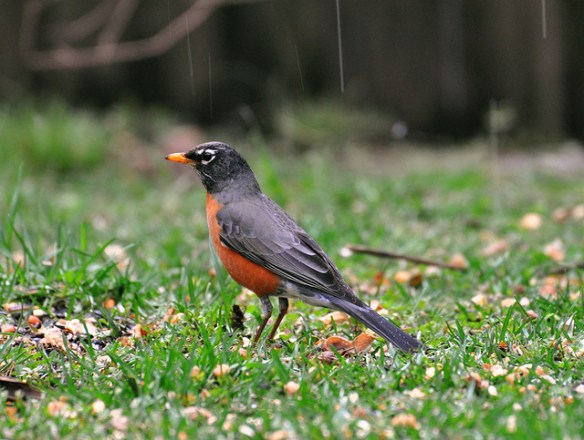
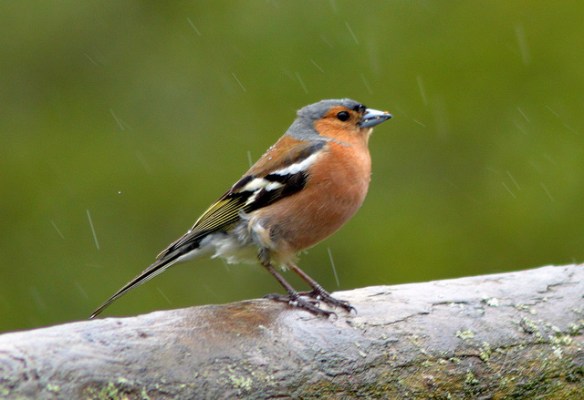
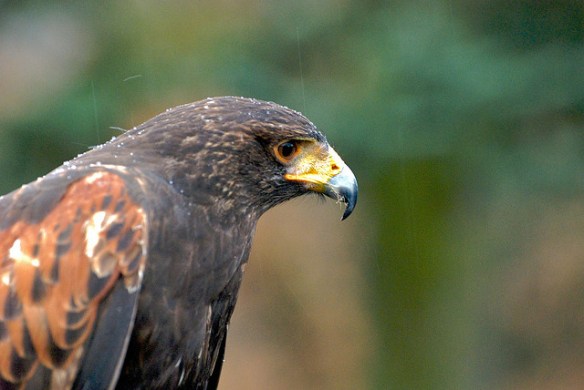
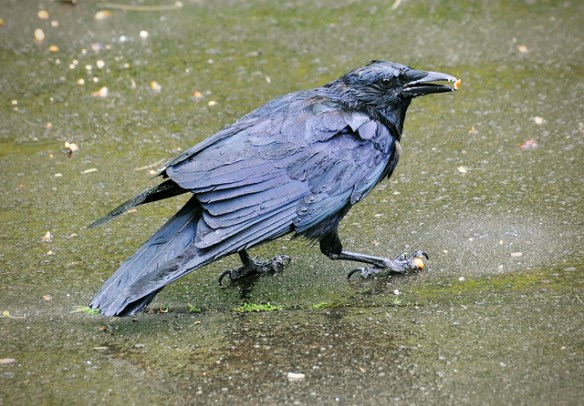

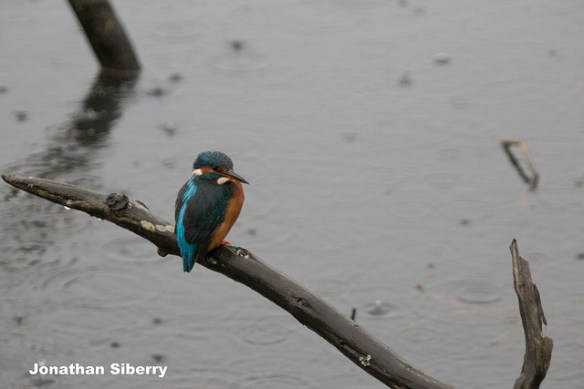
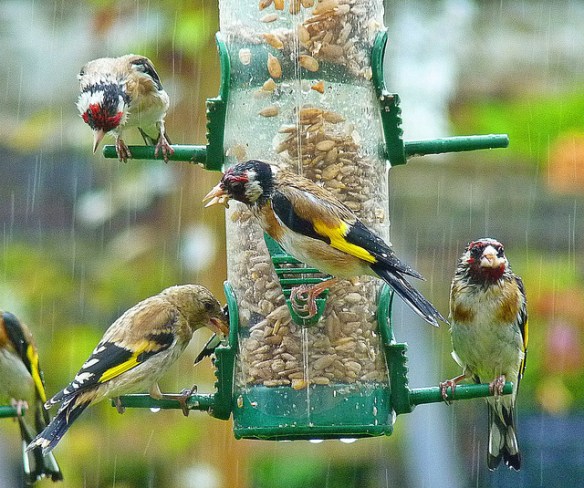
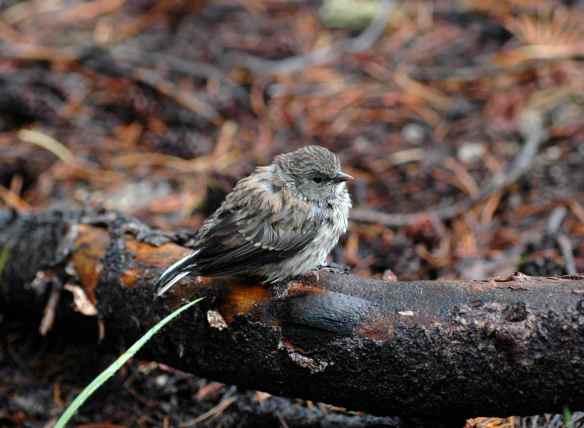
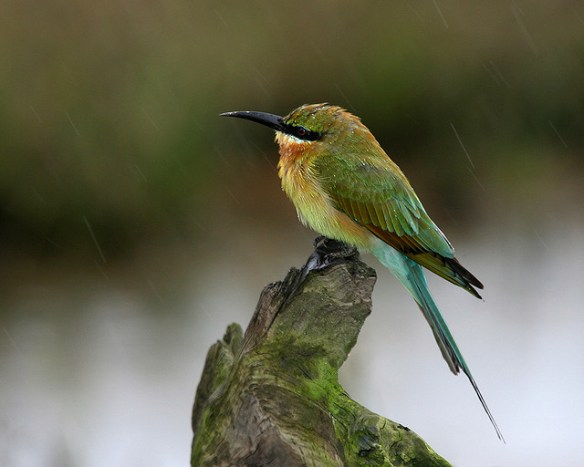
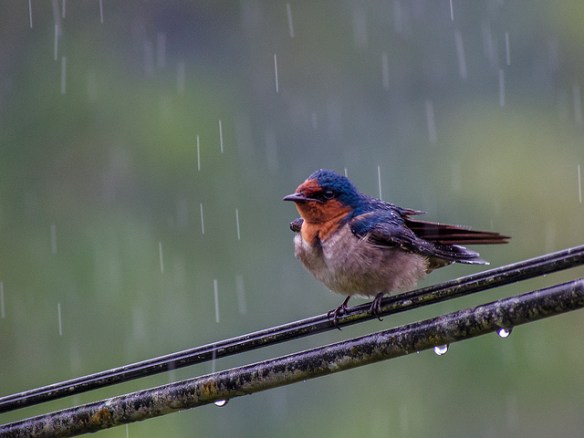
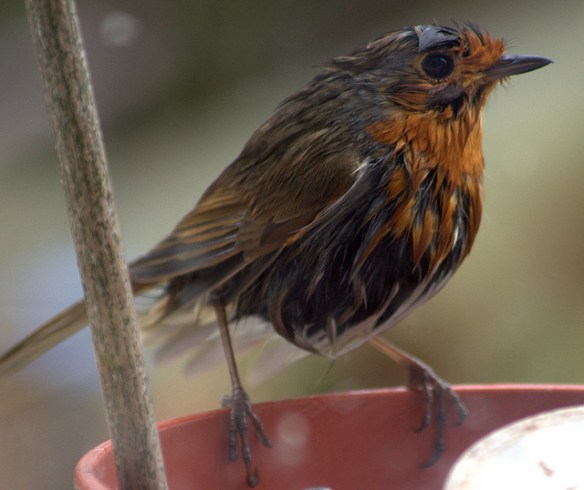

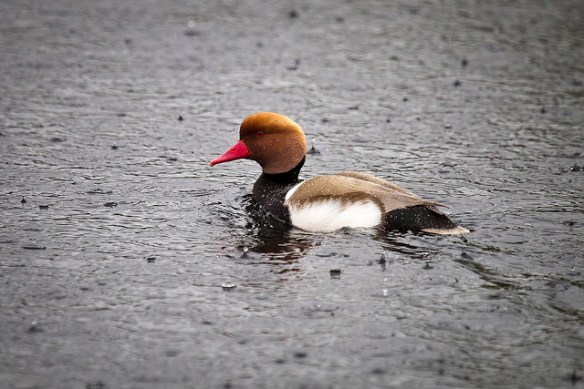
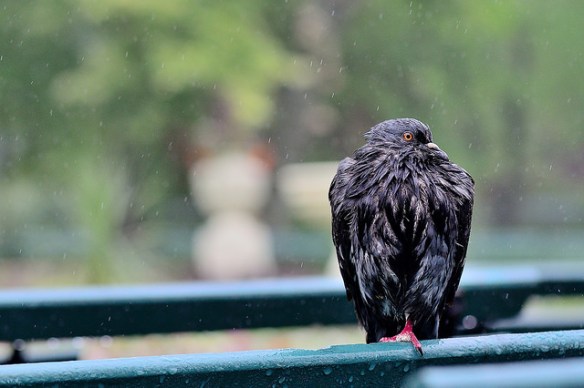
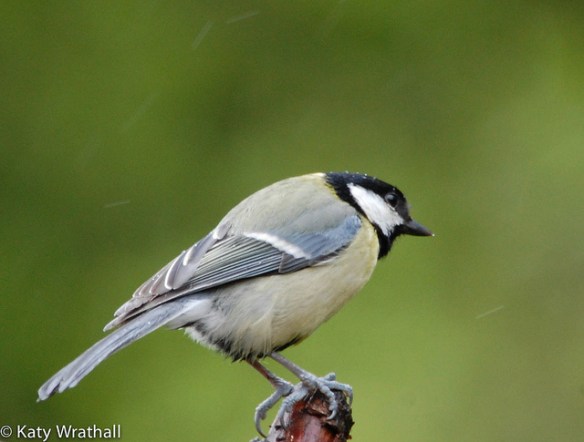
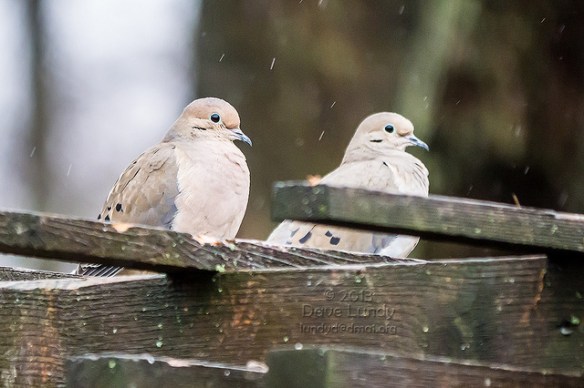
I don’t see how a bush or some reeds can keep a bird dry. When it’s really raining, I can’t stay dry even with an umbrella, and standing under a tree doesn’t help. Is there some trick birds know?
A dense bush, for a small bird, may be pretty decent cover – remember, it takes a while for a tree to get so saturated with water that it stops being shelter. And reducing the amount of water landing on the bird, even if it isn’t reduced all the way to zero, is still helpful. Birds also have to balance other considerations besides getting wet, like escaping from predators: it may be that they choose less-than-optimal rain shelters if the shelters are safer from other dangers.
But if it’s raining hard, birds may not be able to stay dry. They’ll find the best cover they can, hope their feathers can shed whatever water gets to them, and hope it doesn’t rain too long or get too cold.
A cedar tree provides lots of shelter from the rain. Oregan grape underbrush is very important to help the birds protect themselves from bad weather.
As always this is great science writing
Wonderful series of pictures. Thanks for answering the question we all want to know the answer to :-).
With all your factoids, I fear I may be dominating all future conversations!
Haha! Well, be careful – the last person I tried to tell about ant rain physically recoiled and said “I’m going to pretend that I never heard about that.” It’s important to gauge one’s audience first…
True enough … but sometimes it’s fun to get that reaction too!
Naah. Let em eat cake and be ignorant.
Great blogpost. And xkcd. Perfect!
I am trying catch a bird and this ‘t help at all
Thanks for the tour through the bird in the rain experience! Ant rain indeed! I’m watching the few birds out in the rain today, 2nd in a row.
Thank you for such a fun, fact filled and ENTERTAINING answer to that age old question: Where do birds go when it rains?🐧⛈🐦☔️ I had been pondering this question for longer than I care to admit, and I’m thrilled to finally have the answer!! 😊 Not only THE answer, but to know about ant 🐜 rain now too!! Will my expounding knowledge never cease!!?? THANK YOU!!!
So glad you enjoyed it! :-) Thanks so much for your nice comment. (And I, in turn, have learned from your comment that there is an ant emoji!)
Hahahaha, so happy I could “emoji-ly” educate (🐜), haha!!!
I need more help on what they do, like do they panic and get scared or are they calm or ????
Another question, or two or three, or more. We recently had a very heavy & very, very rapidly falling hard hail & rain storm, with very large (golf ball-baseball size) hail – at one time [the rapid & very hard hail (this was the baseball size hail) went on for more than an hour (denting & scratching cars & even breaking windows & scuffing paint off houses), and there were other on & off sessions of lesser (golf ball size & smaller), but very rapid, hail after that lasting a good 45 minutes or less (~20-30 minutes) each]. The heavy, rapid rain that accompanied the hail storms went on for more than10 hours & it was ice cold rain. My questions run similarly to the above questions: where do birds go when it’s hailing [hard & rapidly with large hail (separate question, please)]/what do they do to avoid being injured? My next questions are: do they leave their nests when trying to keep eggs warm during hail storms/heavy, rapid rain that may injure them; do they stay & protect the eggs or seek cover?; also, do they leave a nest of helpless chicks when this kind of hail & rain occurs?
I so enjoyed seeing answers to the original question – very educational. And, I was so surprised & pleased to see that so many other people wondered & worried about our fine, feathered friends.
Thank you in advance for answering my questions
Wow, that’s enormous hail! Here is what I could find about hail and birds: https://toughlittlebirds.com/2014/06/10/the-sky-is-falling-birds-and-hail/
We don’t know a lot about bird behavior during heavy hail, simply because it’s hard for humans to be out observing birds when it’s heavily hailing. Whether nests and birds survive depends on the size of the hail; certainly big hail can kill both. My guess would be that birds would stay on nests as long as the hail wasn’t big enough to be a threat to them, but if it got dangerous, they would seek shelter. It may seem mean to abandon the nest, but the chicks will starve if the parents die, so it doesn’t make sense for the parents to sacrifice themselves to shield chicks from hail.
Many thanks for your knowledgeable reply email & the article within the link. The article was interesting & presented scenarios & thoughts I hadn’t considered. The pictures, however, didn’t illustrate the article very well, & the article was so filled with typos that I had to re-invent what they were trying to convey quite often – I was made ihopeful when I read that “Four dead birds recovered…” (lol). No matter how incredulous that 1 sentence was, overall it was a good article, especially as you wrote “It’s hard for humans to be out observing birds when it’s heavily hailing.” (my observations of the hail storm were made from my living room window – I don’t know of anyone crazy enough to go out in that kind of weather), & I’m sure it wasn’t easy for you to find even that 1 article (as I couldn’t find any at all).
I was pleased to observe that after the hail storm there were only a very few dead birds (small sparrows mostly) on the ground [found a little way from being under trees or near bushes. A few grackles (oh, how San Antonians hate those birds!) were seen dead in the streets]. I hope that after our storms cease our native Texas bird population mortality rate falls way below the ~20% that the article postulated.
Also, I haven’t discovered any nearby bird nests to enable me to report to you any anecdotal observations; however, I have heard the incessant “cheeps” of baby birds very nearby. I’m so relieved that our baby birds survived that hail storm.
The birds were out the next day (it was so eery not to have heard them at all during the night before) & have made their presence known hence – flying to & from & chirping, calling & hooting away – even after some very recent heavy rain storms (no more hail! The rain storms have continued in varying intensities on & off for the past 2 weeks). I’m as pleased (as all of you must be) to see that overall our little feathered friends are surviving our nasty weather quite well [& have probably had fewer accidents than our San Antonio drivers (who don’t even know how to drive in rain – lol)].
Once again, I thank you for responding & for helping to educate us about our little flying friends.
I seen three black birds on a house roof holding one wing each over themselves to keep dry in the rain….. I tried to get a photo on my phone but it was to far away to show on the photo … Amazing to see 😀
Wow, that’s really neat! Thanks for sharing.
That’s amazing!
Thanks so much. It as been helpful
Pingback: When Do Baby Birds Start Flying | Everything About Birds
Great, interesting and amusing article. Thank you.
This site was very interesting. I love learning more about birds. Our yard is a favorite of birds because of our feeders for all kinds of birds. I went to this website because whenever it rains there are always more than a dozen Robins in our yard, but not a different bird to be found. Anyways, thanks for the information!
Loved this article. Great style and sense of humor. Informative and fun to read. I will use the ant-rain whenever I can. Thanks!
Pingback: This webcomic gets it | Tough Little Birds
I have 6 BB chicks ready to fledge today but a steady rain started last night and is forcasted to last another 2 days. Daddy bluebird is doing his best to keep them fed with provided mealworms and foraging but he is already soaked. mommy bluebird only shows up to feed infrequently. will the babies know to stay in the nest a few more days until the weather breaks? temps are 60s daytime high 40s night. worried…
It’s hard to say. I’d guess that the rain (and nighttime cold) would discourage the chicks from fledging, but it depends how old/restless they are, and how little they are being fed. If they are fed too little, they may leave the nest in order to harass their parents more effectively.
They will probably be okay either way; if they are well-developed enough to want to fledge despite the rain, they are likely able to flutter up to low branches (to get off the wet ground), and their parents will lead them to sheltering brush. It would be a good idea for you to avoid the nest until the rain stops, though, as your presence might scare the chicks into fledging when they otherwise wouldn’t.
Thank you! I feel better about this now. We are supposed to get another 1-2″ thru Sat morning so I guess they will stay in the box until the worst part is over. I do know to stay away after day 28 – been observing thru bins.
If I could, I’d comment with a picture of a Great Horned Owl huddling in a tree during a May snowfall. I could see her from both my bedroom and bathroom windows, and she seemed aware of me, and not concerned, although she took off after about 15 minutes. I’ve never seen her or any raptors in that tree even though we live near the top of a mesa and they’re around fairly often and the tree is generally popular with smaller birds.
How can human help the birds?especially when there is tropical cyclone.
In really bad weather, birds will need shelter and food. You could help by putting out bird food (especially anything high in fat, like sunflower seeds, tallow, or just plain old animal fat) and, if you come across exhausted birds huddling in shelter (as you do during migratory “fall-outs” when storms exhaust migratory birds), not disturbing them.
One day last week I hung a beautiful plant on a shepherd’s pole in my front yard. The very next day two birds spent several hours building a nest inside it. It was fun to watch them through my living room window. My concern is that when it rains the nest is going to be soaked. There are probably eggs in it. Or there will be soon. Should I move the basket to a sheltered area, under my carport for instance, or should I leave it where it is?
The answer depends on two things: 1) do you expect it to rain a lot in the next few weeks? and 2) does the plant’s container have drainage?
Generally birds have evolved to do fine in rain, even when nesting. Nests may be sheltered by overhanging leaves; in some cases the parent may even sit on the nest to shelter it. Water drains right out of nests, so in moderate rain the eggs/nestlings don’t end up sitting in water. Rain is only dangerous if it is extreme enough that it ends up flooding the nest, or if it lasts long enough that it harms the parents’ ability to incubate the eggs or to feed the nestlings. A short rain shouldn’t be problem – it’s okay for eggs to be cold for a little while, or for nestlings to not be fed for a few hours.
Back to my two questions: if you expect extreme, prolonged rain, and if the container does not have drainage, then the nest is at risk of being flooded and you might consider moving it. However, I should mention that at this early stage (with eggs not yet laid or only just laid), a disturbance to the nest – like moving it – has a high likelihood of causing the parent birds to simply abandon it and renest somewhere else. Birds are generally fairly willing to abandon eggs if something makes them nervous. (They are quite unwilling to abandon chicks, so if the eggs hatch and you then have reason to worry about rain, you might move the nest then.)
Thank you for answering so quickly. I feel better now. The planter does have holes in the bottom. We had a light rain earlier today, and expect more tomorrow. I will just play it by ear, or eye rather, and if it rains really hard for a long time I will move it. Thanks again.
There was a robin who set in the rain(with thunder) and I was worried—- now not somuch….Thanks!
And for the next big question on my mind:
Do birds like living in gutters?
I do worry about them in the heavy showers. Poor little things. I have starlings and sparrows in them.
What a wonderful, wonderful explanation. Fine writing, and the brevity only made the wealth of information more impressive.
I live in a building by a lar\ge body of water in Florida, and I often enjoy watching our avian friends from my back porch. But with everything so manicured outside, and no other real shelter, I often wondered where they went during our many heavy, torrential rains. Then one day as the rain began and swiftly began to reain harder, I saw a small sparrow flutter in front of me, then zoom horizontally perhaps 100 feet, right into a well manicured… hedge. It was no less wet in there, but a least it wasn’t being beaten to death by what must have felt like a thousand bullet-like raindrops.
Thanks so much for your kind words! Yes, lawns are bad bird habitat for several reasons – e.g. they’re usually pesticide-treated, meaning not good for finding food – and they certainly wouldn’t provide much shelter. I’m always impressed by the spaces birds can use in our too-organized human habitats: hanging flower baskets and nooks under roof tiles for nesting, the fronts of cars for foraging (all those smashed bugs on the windshield… yum), and your manicured hedge for shelter sounds just right.
What about doves sitting on there eggs in the POURING rain?
Usually they build nests in sheltered areas. If the rain is really unusually heavy, it’s possible that the dove may abandon the nest to seek better shelter – REALLY bad weather can confound just about any wild animal – but generally rain isn’t a big deal for birds who nest in trees, like doves. (If the nest is on a ledge, the rain might be a bit more problematic.) Rain can be a lot worse for birds who nest on the ground, where the water may settle into a puddle.
Dear,
This world is full of His wonderful creations. Birds are one of them. Their life is free, no demands no botherings. We being a human being need a lot to learn from it. Observing bird’s movements is an enjoyable event. Love them & give a helping hand at your best to protect them.